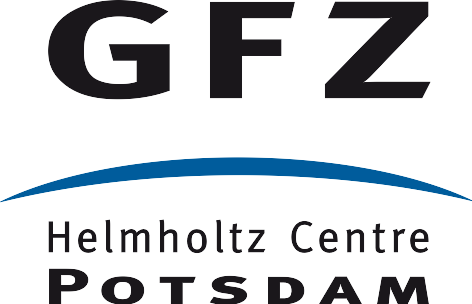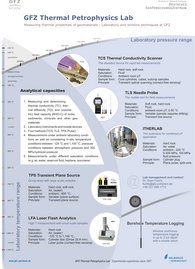The lab is a facility maintained by the working group ‘Exploration of Thermal Geosystems’ of section 4.8. The lab produces data that are part of projects related to the analysis of the Earth temperature field. We measure thermal conductivity (TC), thermal diffusivity (TD) or volumetric heat capacity (RHOC) of dry and saturated rocks or geomaterials under ambient laboratory or in-situ temperature conditions. The following devices are available for measurements:
- Thermal conductivity scanner (TCS, for TC/TD, ambient laboratory conditions)
- Needle probe, transient line source (MP2, ambient p, T up to 50°C)
- Hotdisc, transient plane source (TPS1500, ambient p, T up to 600 °C)
- Laser-flash analysis (LFA 457, for TD, RHOC, ambient p, T up to 1100 °C)
- Dilatometer (DIL L75 HD, for RHO, ambient, T up to 1000 °C) - ab Q1/2024
We have a laboratory device in the testing that based on a modified pulse method and allows for dry and saturated rocks measurements at simultaneously raised pressure and temperature, respectively.
We have extensive lab experience with all types of rocks (sedimentary rocks, magmatic and metamorphic rocks). Saturation of rocks is accommodated with varying fluids (air, tap water, distilled water, heptane, etc.). The best raw material for analysis is full core, but thermal properties can be also measured from half core or cutting samples. For the preparation of samples the GFZ facilities are employed. We also provide service measurements. For information on sample analysis and conditions and processes contact us by email.
- Fuchs, S., Förster, H.-J., Norden, B., Balling, N., Miele, R., Heckenbach, E. L., Förster, A. (2021): The thermal diffusivity of sedimentary rocks: empirical validation of a physically based α − ϕ relation. - Journal of Geophysical Research: Solid Earth, 126, 3, e2020JB020595.
- Fuchs, S., Förster, H., Braune, K., Förster, A. (2018). Calculation of Thermal Conductivity of Low-Porous, Isotropic Plutonic Rocks of the Crust at Ambient Conditions From Modal Mineralogy and Porosity: A Viable Alternative for Direct Measurement?. - Journal of Geophysical Research 123(10): 8602-8614.
- Schintgen, T., A. Förster, H.-J. Förster and B. Norden (2015). Surface heat flow and lithosphere thermal structure of the Rhenohercynian Zone in the greater Luxembourg region. Geothermics 56(0): 93-109.
- Ray, L., H.-J. Förster, A. Förster, S. Fuchs, R. Naumann and O. Appelt (2015). Tracking the thermal properties of the lower continental crust: Measured versus calculated thermal conductivity of high-grade metamorphic rocks (Southern Granulite Province, India). Geothermics 55(0): 138-149.
- Schütz, F., H.-J. Förster and A. Förster (2014). Thermal conditions of the northern Sinai Microplate inferred from new surface heat-flow values and continuous borehole temperature logging in central and southern Israel. Journal of Geodynamics 76: 8-24.
- Fuchs, S., F. Schütz, H.-J. Förster and A. Förster (2013). Evaluation of common mixing models for calculating bulk thermal conductivity of sedimentary rocks: correction charts and new conversion equations. Geothermics 47(-): 40–52.
- Schütz, F., B. Norden, A. Förster and D. Group (2012). Thermal properties of sediments in southern Israel: a comprehensive data set for heat flow and geothermal energy studies. Basin Research 24(3): 357-376.
- Fuchs, S. and A. Förster (2010). Rock thermal conductivity of Mesozoic geothermal aquifers in the Northeast German Basin. Chemie der Erde-Geochemistry 70(S 3).
Measurements were performed in the frame of scientific cooperations or projects for the following instituts and companies (selection):
- University of Bologna (Italy)
- Aarhus University (Dänemark)
- Technical University Darmstadt (Germany)
- Dublin Institute for Advanced Studies (Ireland)
- University of Leads (UK)
- EAVOR (Canada)
- Geomecon (Germany)
- BGE (Germany)



